Abstract
Bryophytes are one of the main resources for bird nest construction; however, studies are limited and have been oriented to preliminary species lists. We evaluated for the first time in Ecuador the changes in the richness and composition of bryophytes in 17 nests of the species Myadestes ralloides and Catharus fuscater, of the family Turdidae. The presence/absence of bryophytes was recorded in each nest. A total of 25 bryophyte species were recorded (13 mosses and 12 liverworts). The most frequent species in the nests of the two species were the mosses Thuidium tomentosum and Meteoridium remotifolium and the liverworts Trichocolea flaccida and Frullania peruviana. The results indicated that bryophyte species’ richness and composition did not differ between the nests of the two studied bird species, because they select similar bryophyte species for nest elaboration. In general, our study showed that for the two species of birds of the family Turdidae, mosses and liverworts are key components in the elaboration of nests both internally and externally. On the other hand, we would suggest that further investigations should focus on analyzing the relation between bird nests and bryophyte phytochemistry, as well as the functional traits of bryophytes.
1. Introduction
The functioning and structure of communities depend on ecological interactions, as they play a crucial role in the generation and preservation of biodiversity [1]. In this case, a large number of birds globally use plant material to build their nests to allow the reproduction and development of nestlings [2,3]. Most bird species build their nests with vegetation, such as vascular species (e.g., ferns), bryophytes, and lichens [4,5,6,7]. Bryophytes increase water retention, thermal insulation, and antimicrobial activity [3,8,9]. There are many studies on nests constructed with vascular plants, but few on nests constructed with bryophytes [7,10].
In Chile, the species Sephanoides sephaniodes, selects scales from the leaves of the fern Lophosoria quadripinnata and moss species (Ancistrodes genuflexa, Weymouthia mollis, and Weymouthia cochlearifolia) for nest building [6,11]. In Brazil, 57 bryophyte species have been reported associated with 21 nests of different species [10]. Likewise, 22 bryophyte species (16 mosses and 6 liverworts) were cited in nests of two bird species (Sephanoides sephaniodes and Oreotrochilus leucopleurus) in Argentina [4]. Despite this, our knowledge of the diversity of bryophytes associated with bird nests in Ecuador has not been documented to date. Therefore, the construction of bird nests with the available bryophyte species in tropical forests remains largely unexplored.
Myadestes ralloides and Catharus fuscater are two species of blackbirds (Turdidae) commonly distributed in Ecuador [12], where most studies have focused on understanding their reproductive biology [13,14,15]. The nests of these species are typically built using mosses and fern scales [13,14]. Nevertheless, there is a lack of comprehensive information regarding the bryophyte species found in bird nests, despite the high diversity of bryophytes in Ecuador with 1600 species, of which 900 are mosses and 700 are liverworts and hornworts [16,17,18]. Most studies have used bryophytes as bioindicators of air pollution [19] and forest disturbance [20,21]. On the other hand, more than 1700 bird species have been reported [22]; however, currently there is a lack of information regarding the species of bryophytes used by different birds when constructing their nests. Under this background, the main objective of this research is to determine changes in the richness and composition of bryophytes associated with two bird species of the family Turdidae in Ecuador.
2. Materials and Methods
2.1. Study Area
The study was conducted at the Yanayacu Biological Station (Figure 1), located 5 km from Cosanga in Napo province between 1950 and 2010 m elevation [13]. The vegetation formation corresponds to low montane evergreen forest of the northern part of the Eastern Cordillera of the Andes.
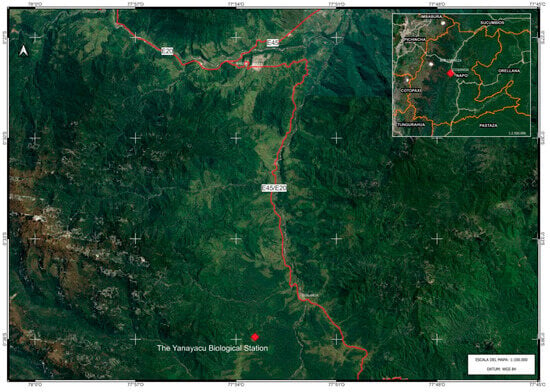
Figure 1.
Study area at the Yanayacu Biological Station.
2.2. Design and Data Collection
A survey of 10 abandoned nests of Myadestes ralloides and 7 of Catharus fuscater was conducted. The nests were dried at room temperature to prevent damage of bryophyte samples. Each nest was carefully examined both internally and externally to visualize the presence of bryophytes. In each nest, the presence/absence of bryophytes associated with each species was recorded. Finally, the identification of bryophyte species was carried out by utilizing both general and specialized keys [18,23,24].
Myadestes ralloides
M. ralloides (Figure 2) is known as the Andean solitaire; it is distributed from northwestern Venezuela to southern Bolivia, and inhabits the interior and edges of humid forests between 800 and 2700 m elevation [25]. Their nests are thick, open cups composed predominantly of mosses, with a layer of fern scales covering the inside. They are located in varied sites such as the trunks of large trees and in ravines. The subspecies found in the study area is Myadestes ralloides subs venezuelensis [12], and nests mainly during rainy seasons [13].
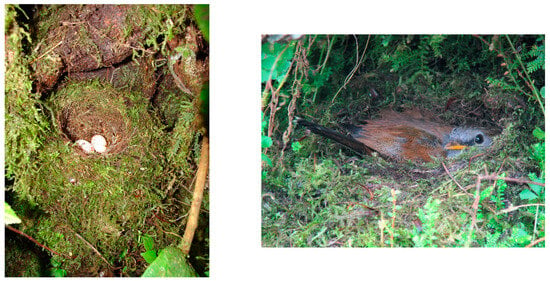
Figure 2.
Nest in the field of Myadestes ralloides at the Yanayacu Biological Station.
Catharus fuscater
A non-migratory species, C. fuscater (Figure 3) is distributed from Costa Rica to Bolivia, in humid forests between 800 and 2600 m elevation [25]. Its nests are very similar to those of M. ralloides, but the inner chamber is composed of fine, pale fibers instead of fern scales. The subspecies C. fuscater is found in our study area [12] and nests throughout the year, but mainly during dry periods [14,15].
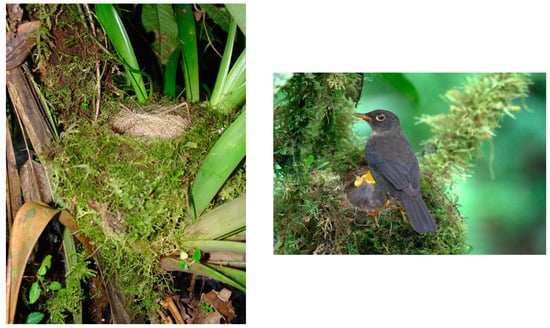
Figure 3.
Nest in the field of Catharus fuscater at the Yanayacu Biological Station.
2.3. Analysis of Data
To visualize changes in species richness as a function of the two bird species, we performed a violin plot. To analyze the relationship between species richness and the two bird species we performed a Student’s t-test, because the data presented a normal distribution according to the Shapiro–Wilk test (p-value = 0.7414).
A non-metric multidimensional scaling analysis (NMDS) was performed to visualize the similarity between the bryophyte species composition in the nests of the two bird species, using the Bray–Curtis distance and 999 Monte Carlo permutations. Finally, to analyze the effect of the two bird species on bryophyte species composition in the nest, a permutational multivariate analysis of variance (PERMANOVA) was performed. All analyses were performed with the R software and the statistical package “vegan” [26].
3. Results and Discussion
A total of 25 species of bryophytes associated with the nests of the two bird species were recorded, of which 13 were mosses and 12 were liverworts (Table 1). Nineteen species were recorded for Myadestes ralloides and seventeen for Catharus fuscater (Table 1). The number of bryophytes cited in our study (25 species) is higher than the 22 species [4], 7 species [6], and 15 species [27] reported in previous studies. Supporting our results, Calvelo et al. [4] have shown that mosses and liverwort are the dominant components in nest construction. However, De Almeida et al. [10] report a higher number, with 57 species of bryophytes in 21 birds’ nests, but the bird’s nest does not contain any information regarding the specific species of bird responsible for constructing it. Thus, the researchers point out that liverworts present a higher number of species; however, mosses are the structural elements of nest building.

Table 1.
Bryophyte species associated with Myadestes ralloides and Catharus fuscater nests. Numbers represent the frequency of bryophyte species in each nest of the two species.
The most frequent species in the nests of the two species were the mosses Thuidium tomentosum, Meteoridium remotifolium, Porotrichum mutabile, and Squamidium nigricans. In accordance, in a study conducted by Rydgren et al. [27], it was found that there are 15 species of mosses (e.g., Pleurozium schreberi (Willd. ex Brid.) Mitt., Rhytidiadelphus squarrosus, and Sanionia uncinata) used as nest materials. In the same line, Andreas [28] has shown that Carolina chickadees (Poecile carolinensis) utilized ten different types of mosses such as Platygyrium repens (Brid.) Schimp. for nest construction, where these species were not randomly selected, because all taxa were epiphytes. Finally, in the tropical zone, De Almeida et al. [10] report that the commonest moss species were Floribundaria flaccida (Mitt.) Broth., Squamidium brasiliense (Hornsch.) Broth., and Zelometeorium patulum (Hedw.) Man.
As for liverworts, Plagiochila sp1, Trichocolea flaccida and Frullania peruviana, Bazzania hookeri, and Metzgeria leptoneurawere were the most abundant (Table 1). In accordance, Breil and Moyle’s [29] study found corticolous species of Frullania genera. Similarly, Andreas [10] reports that the commonest liverwort species were Frullania eboracensis Gottsche and Porella platyphylla (Linneaus) Pfeiffer. In the same line, liverwort genera Frullania, Plagiochila, and Metzgeria were found in birds’ nests in Brazil [10] and Argentina [4].
The violin plot shows a higher trend of species richness for Myadestes ralloides compared to Catharus fuscater, but the t-test indicated that there is no significant difference between the species richness of bryophytes associated with the nests of the two bird species (Figure 4).
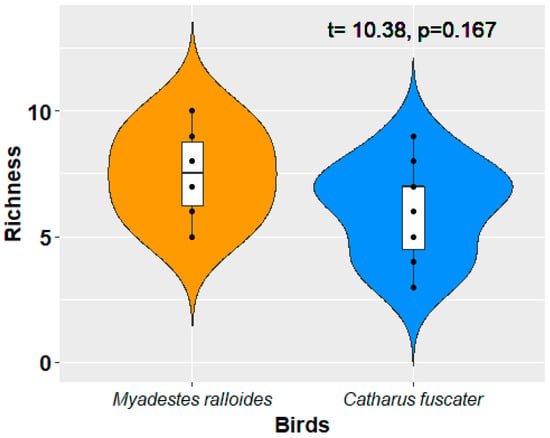
Figure 4.
Violin diagram of the richness of bryophytes associated with Myadestes ralloides and Catharus fuscater.
On the other hand, the NMDS indicated that the bryophyte composition is similar for the two bird species (Figure 5).
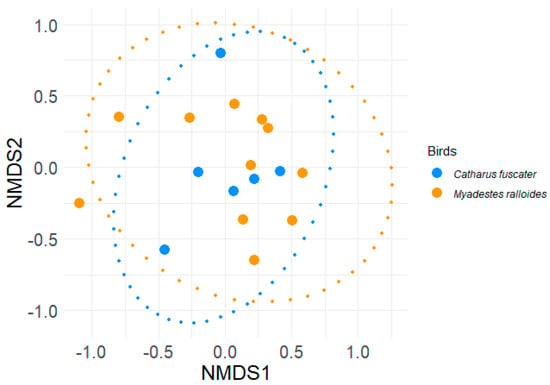
Figure 5.
NMDS of the bryophyte composition associated with Myadestes ralloides and Catharus fuscater.
Corroborating these results, the PERMANOVA indicated that there is no effect of bird species on bryophyte species composition (F = 1.740, p-value = 0.126). In accordance, Glądalski et al. [30] have shown that the bryophyte species’ composition of the nests seems to be affected by forest composition (urban vs. forest) rather than the bird species. Thus, other important factors related with forest vegetation and structure [30], the phytochemistry of bryophytes (e.g., antimicrobial, antifungal, antiseptic) [31], and bryophyte traits (e.g., size) are clearly understudied in temperate and tropical zones. For example, several birds use moss species partially as a function of the size of the tree cavity they use for nesting [7].
There are several limitations of this study, which may be improved in the future studies. Firstly, this study used a small sample size of bird nests (n = 10 and n = 7) and bird species. Due to the limitations of our data set, this study only used two bird species, which may not comprehensively reflect the relation between bryophyte diversity and bird nest building. Secondly, a more precise resolution and detailed data set are needed. The current study does not include a data set with the microclimatic factors, which is relatively coarse and limits the discussion of other important drivers at local scales. Thirdly, future studies should try to predict the effects of bryophyte traits and forest vegetation and structure on bird nest building, which may inform conservation strategies.
4. Conclusions
We registered a high diversity of bryophytes (25 species) associated with the bird species Myadestes ralloides and Catharus fuscater, where the mosses Thuidium tomentosum and Meteoridium remotifolium and liverworts of the family Plagiochilaceae (Plagiochila sp1), Trichocolea flaccida, and Frullania peruviana were the main components of the nests building. In addition, we documented for the first time that two bird species selected similar bryophyte species for nest building in the tropical zone. Therefore, we would suggest that further investigations should focus on analyzing the relationship between bird nests and phytochemistry, and the functional traits of bryophytes (e.g., size, growth form).
Author Contributions
Methodology, analysis, and writing—original draft preparation: Á.B., E.J., E.Y.-S. and H.F.G. Conceptualization and writing—review and editing: Á.B., E.J., E.Y.-S. and H.F.G. All authors have read and agreed to the published version of the manuscript.
Funding
This research was funded by Private Technical University of Loja.
Institutional Review Board Statement
Not applicable.
Data Availability Statement
Data are contained within the article.
Acknowledgments
We thank the Ministerio del Ambiente, Agua y Transición Ecológica del Ecuador for providing access to the study areas. We thank Sebastián Dueñas for making the map of the study area.
Conflicts of Interest
The authors declare no conflict of interest.
References
- Bascompte, J.; Jordano, P. Plant-animal mutualistic networks: The architecture of biodiversity. Annu. Rev. Ecol. Evol. Syst. 2007, 38, 567–593. [Google Scholar] [CrossRef]
- Healy, S.D.; Morgan, K.V.; Bailey, I.E. Nest construction behaviour. In Nests, Eggs and Incubation: New Ideas about Avian Reproduction; Deeming, D.C., Reynolds, S.J., Eds.; Oxford University Press: Oxford, UK, 2015; pp. 16–28. [Google Scholar]
- Fontúrbel, F.E.; Osorio, F.; Riffo, V.; Nuñez, M.; Bastias, R.; Carvallo, G.O. Mamma knows best. Ecology 2020, 101, 1–4. [Google Scholar] [CrossRef] [PubMed]
- Calvelo, S.; Trejo, A.; Ojeda, V. Botanical composition and structure of hummingbird nests in different habitats from northwestern Patagonia (Argentina). J. Nat. Hist. 2006, 40, 589–603. [Google Scholar]
- McCormac, J.; Showman, R.E. Lichen composition in Blue-gray Gnatcatcher and Ruby-throated Hummingbird nests. Ohio Cardinal 2010, 33, 72–82. [Google Scholar]
- Osorio-Zuñiga, F.; Fontúrbel, F.E.; Rydin, H. Evidence of mutualistic synzoochory between cryptogams and hummingbirds. Oikos 2014, 123, 553–558. [Google Scholar] [CrossRef]
- Wesołowski, T.; Wierzcholska, S. Tits as bryologists: Patterns of bryophyte use in nests of three species cohabiting a primeval forest. J. Ornithol. 2018, 159, 733–745. [Google Scholar]
- Blem, C.R.; Blem, L.B. Composition and microclimate of Prothonotary Warbler nests. Auk 1994, 111, 197–200. [Google Scholar] [CrossRef]
- D’Alba, L.; Shawkey, M.D. Mechanisms of antimicrobial defense in avian eggs. J. Ornithol. 2015, 156, S399–S408. [Google Scholar]
- De Almeida Amélio, L.; Marchi Do Carmo, D.; Soares De Lima, J.; Fernandes Peralta, D. Bryophytes as a material to build birds’ nests in Brazil. Bol. Soc. Argent. 2017, 52, 199–208. [Google Scholar] [CrossRef]
- Torres Dowdall, J.R.; Osorio, F.; Suarez, G.M. Materiales utilizados por el Picaflor Rubí (Sephanoides sephaniodes) para la construccion de nidos en la selva Valdiviana, Chile. Ornitol. Neotr. 2007, 18, 433–437. [Google Scholar]
- Freile, J.F.; Restall, R.L. Birds of Ecuador; Bloomsbury Publishing Plc.: London, UK, 2018. [Google Scholar]
- Greeney, H.F.; Halupka, K. Nesting biology of the Andean Solitaire (Myadestes ralloides) in northeastern Ecuador. Ornitol. Neotrop. 2008, 19, 213–219. [Google Scholar]
- Greeney, H.F.; Dyrcz, A.; Mikusek, R.; Port, J. Cooperative breeding at a nest of Slaty-backed Nightingale-Thrushes (Catharus fuscater). Wilson J. Ornithol. 2015, 127, 323–325. [Google Scholar] [CrossRef]
- Dyrcz, A.; Port, J.; Mikusek, R.; Greeney, H.F. Parental care of nestlings in the Slaty-backed Nightingale-Thrush (Catharus fuscater) in eastern Ecuador. Ornitol. Neotrop. 2015, 26, 117–123. [Google Scholar] [CrossRef]
- Churchill, S.P.; Griffin, D.; Muñoz, J. A Checklist of the Mosses of the Tropical Andean Countries; Editorial CSIC; CSIC Press: Madrid, Spain, 2000; Volume 17. [Google Scholar]
- León-Yánez, S.; Gradstein, S.R.; Wegner, C. Hepáticas (Marchantiophyta) y antocerotas (Anthocerotophyta) del Ecuador: Catálogo. Herbario QCA; Pontificia Universidad Católica del Ecuador: Quito, Ecuador, 2006. [Google Scholar]
- Gradstein, S.R. The Liverworts and Hornworts of Colombia and Ecuador; Springer: Berlin/Heidelberg, Germany, 2021. [Google Scholar]
- Bignal, K.L.; Ashmore, M.R.; Headley, A.D. Effects of air pollution from road transport on growth and physiology of six transplanted bryophyte species. Environ. Pollut. 2008, 156, 332–340. [Google Scholar] [CrossRef]
- Nöske, N.M.; Hilt, N.; Werner, F.A.; Brehm, G.; Fiedler, K.; Sipman, H.J.; Gradstein, S.R. Disturbance effects on diversity of epiphytes and moths in a montane forest in Ecuador. Basic. Appl. Ecol. 2008, 9, 4–12. [Google Scholar] [CrossRef]
- Medina, J.; Quizhpe, W.; Deleg, J.; Gonzalez, K.; Aguirre, Z.; Aguirre, N.; Benítez, A. Are Juglans neotropica Plantations Useful as a Refuge of Bryophytes Diversity in Tropical Areas? Life 2021, 11, 434. [Google Scholar] [CrossRef]
- Freile, J.F.; Brinkhuizen, D.M.; Greenfield, P.J.; Lysinger, M.; Navarrete, L.; Nilsson, J.; Boyla, K.A. Lista de Las Aves del Ecuador/Checklist of the Birds of Ecuador; Comité Ecuatoriano de Registros Ornitológicos: Quito, Ecuador, 2015. [Google Scholar]
- Churchill, S.P.; Linares, C.E. Prodromus Bryologiae Novo-Granatensis: Introduccion a la Flora de Musgos de Colombia; Instituto de Ciencias Naturales: Bogota, Colombia, 1995. [Google Scholar]
- Gradstein, S.R.; da Costa, D.P. The Hepaticae and Anthocerotae of Brazil; New York Botanical Garden Press: New York, NY, USA, 2003; Volume 87, pp. 1–318. [Google Scholar]
- Collar, N.J. Family Turdidae (thrushes). In Handbook of the Birds of the World; Cornell Lab of Ornithology: Ithaca, NY, USA, 2005; Volume 10, pp. 514–807. [Google Scholar] [CrossRef]
- Oksanen, J.; Blanchet, F.G.; Kindt, R.; Legendre, P.; Minchin, P.R.; O’hara, R.; Simpson, G.L.; Solymos, P.; Stevens, M.H.H.; Wagner, H.; et al. Package ‘Vegan’. Community Ecology Package, Version 2.4-4. Available online: https://cran.r-project.org/web/packages/vegan/index.html (accessed on 24 August 2019).
- Rydgren, K.; Indreeide, B.; Slagsvold, T.; Lampe, H.M. Nest building in titmice Paridae: Selectivity in bryophyte use. Ecol. Evol. 2023, 13, e9852. [Google Scholar] [CrossRef]
- Andreas, B.K. Use of bryophytes by Carolina chickadees (Poecile carolinensis) in nest construction. Evansia 2010, 27, 23–29. [Google Scholar] [CrossRef]
- Breil, D.A.; Moyle, S.M. Bryophytes used in construction of bird nests. Bryologist 1976, 79, 95–98. [Google Scholar] [CrossRef]
- Glądalski, M.; Wolski, G.J.; Bańbura, M.; Kaliński, A.; Markowski, M.; Skwarska, J.; Wawrzyniak, J.; Bańbura, J. Differences in use of bryophyte species in tit nests between two contrasting habitats: An urban park and a forest. Zool. J. Linn. 2021, 88, 807–815. [Google Scholar] [CrossRef]
- Asakawa, Y. Biologically active compounds from bryophytes. Pure Appl. Chem. 2007, 79, 557–580. [Google Scholar] [CrossRef]
Disclaimer/Publisher’s Note: The statements, opinions and data contained in all publications are solely those of the individual author(s) and contributor(s) and not of MDPI and/or the editor(s). MDPI and/or the editor(s) disclaim responsibility for any injury to people or property resulting from any ideas, methods, instructions or products referred to in the content. |
© 2023 by the authors. Licensee MDPI, Basel, Switzerland. This article is an open access article distributed under the terms and conditions of the Creative Commons Attribution (CC BY) license (https://creativecommons.org/licenses/by/4.0/).